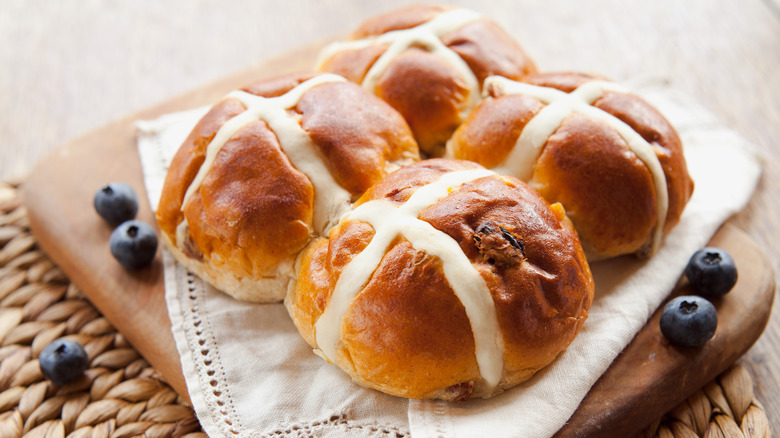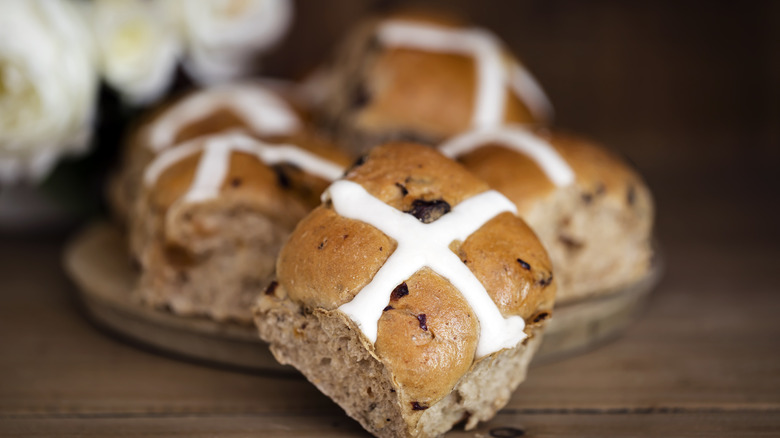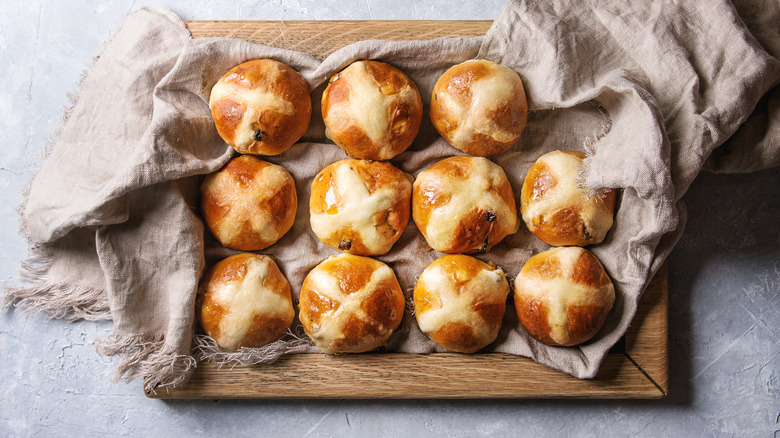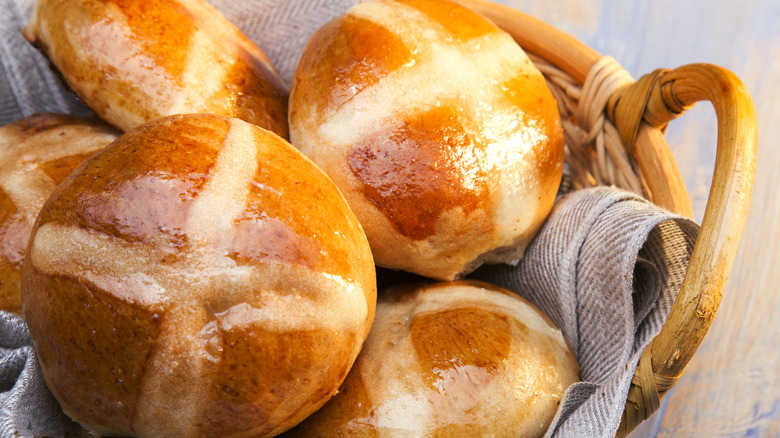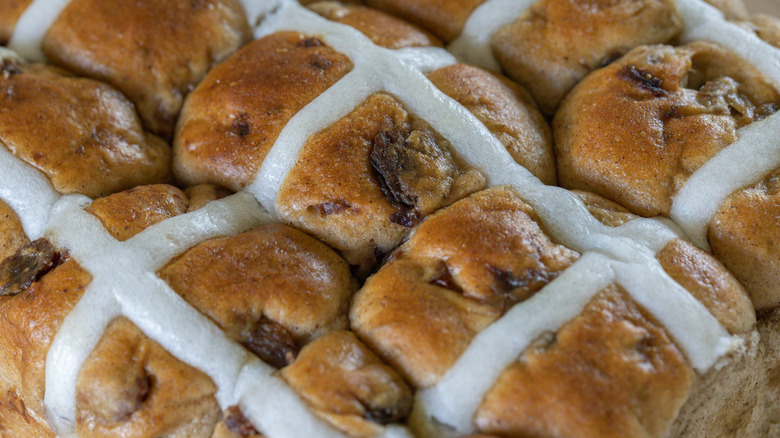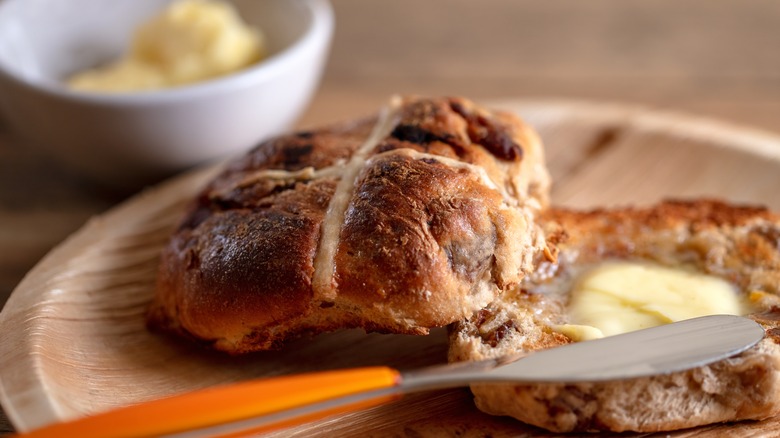Why Hot Cross Buns Are An Easter Tradition
There are a lot of things we commonly associate with the Easter season, both religiously and secularly. One of the many hallmarks of the season includes the stockpiling of candies and confections, whether it's those boxes of solid milk chocolate rabbits on grocery store shelves or a handful of jelly beans nestled among colorful plastic grass in an Easter basket.
Much like Valentine's Day, Easter is a big holiday for candy and sweets manufacturers. A 2021 survey from InfoPlease reported that an incredible $2.26 billion worth of candy was sold in 2014 alone, with demand for everything from chocolate to jelly beans to Peeps, only continuing to skyrocket. Famed jelly bean producer Jelly Belly estimated that, in 2018, people consumed over 5 billion jelly beans during the Easter season. Needless to say, no matter if you like digging into a Cadbury egg or eating some stale Peeps, you can't deny that sweet and sugary snacks are as much a part of Easter as Peter Rabbit and egg hunts.
But what about hot cross buns? No, we're not talking about that one song they made you learn in elementary school, we're talking about the real thing. What exactly are these candied pastries and what, if anything, do they have to do with the Easter season?
What are hot cross buns?
Hot cross buns may be the name of a song you vaguely remember singing when you were a kid, but their namesake actually refers to a real and popular dessert. Hot cross buns are generally made of lightly-sweetened yeast dough, usually filled with fruits, nuts, and spices, and then glazed and topped with icing. This icing is added, in the shape of a cross, while the bun is still warm, leading to the term "hot cross buns." Picture Texas Roadhouse rolls, but topped with icing and raisins.
If you want to make hot cross buns for yourself this Easter season, it's relatively easy. Simply combine warmed milk, yeast, and sugar in a bowl alongside raisins, spices like cinnamon and nutmeg, candied citrus peels, eggs, and butter. Knead the newly-formed dough into a ball and allow it to sit in a covered, well-oiled bowl for an hour until it doubles in size. Then, divide this dough into equal pieces, going by how big or small you want your rolls, and then brush the rolls with an egg-and-water wash. Bake the rolls for 20 minutes at 400 degrees or until the rolls are golden-brown. Once the buns have been cooked, pipe the icing of your choice across their tops, forming a "plus" or cross shape.
The end result should be a sweet, warm, and buttery roll that has hints of cinnamon and fruit with a creamy, light frosting.
Hot cross buns may have been created by monks
Okay, so we got what hot cross buns are out of the way, but we still have yet to answer the question as to what exactly they have to do with Easter.
One legend claims an English monk in the 12th century baked the rolls during Good Friday and marked them with a cross shape in order to signify the occasion. Another story, however, tells us about one Brother Thomas Rocliffe, a monk at the St. Albans Abbey during the 14th century, who baked what he called "Alban buns." The buns, while omitting the dried fruit found in modern versions, bore a very close resemblance to hot cross buns. Rocliffe's rolls also shared the traditional cross shape, signifying their connection to the Church and Good Friday.
Whoever invented the buns, it's no secret that they took off in popularity, particularly during the Easter holiday and other religious weekends. They were cheap, common, and even believed to have magical and medical properties to them. Although eating a hot cross bun today won't cure the common cold or banish demons from your house (at least as far as we know), you can still enjoy these buns with friends and family just as the good people of fourteenth-century England enjoyed all those years ago.
Queen Elizabeth I strictly regulated the sale of the buns
The relationship between the English monarchy and the Catholic Church has always been a bit heated. Just take a look at old King Henry VIII to see his opinions on the Catholic Church, for example. But Queen Elizabeth I, while not going so far as to convert England to Protestantism to divorce her partner, actually regulated the sale of the "holy" hot cross buns.
As the story goes, Elizabeth I didn't so much as "ban" hot cross buns as she allowed the sale of the pastries only on religious holidays, such as Easter and Christmas, and during certain burials. The reason for this has to do with the belief that hot cross buns were believed to have "magic" properties, as we mentioned earlier. People firmly believed that, by hanging the buns from roofing beams or drying them into powder, they could cure wounds and sicknesses, and drive out evil spirits. The regulation of selling the buns would help to keep them "holy," since they would then only be associated with religious holidays rather than any types of magic or urban legends.
Other stories, however, go so far as to say Elizabeth I actually tried to ban the buns outright, considering them a "papist holdover." But the demand for iced buns was so great that Elizabeth I compromised and allowed the desserts to be sold on religious holidays. As we said, sometimes the monarchy and ministry don't get along.
Hot cross buns symbolize Jesus Christ's resurrection
As any Christian could tell you, the cross is meant to symbolize Jesus Christ's crucifixion and resurrection. It would make sense, then, to have a cross on the hot cross buns during the Easter season — the turning of Christ's punishment into a symbol of victory. While that's one of the reasons why hot cross buns are so popular on Easter, the buns are also meant to symbolize Jesus Christ in another way.
The icing on the bun doesn't just represent the cross, but it's also been stated that the spices used in the baking of the bread are meant to invoke the spices used in the embalming of Christ's body. Another interesting legend associated with the bun is that, should you prepare it on Good Friday, the bread will not decay. This is meant to symbolize how, even after being dead for three days, Christ's body remained unchanged and he looked exactly as he did before, something mirrored in the idea that the bread will not change in any way after being removed from the oven.
While it may not be true that the hot cross bun won't rot or get moldy, the bun is also enjoyed around the Lenten season, as practicing Catholics don't consume meat or dairy-based products on Fridays. Even if the bun itself may not be divine in nature, it still makes for a pretty good dessert after Easter dinner.
The buns may also have roots in Paganism
With all of this discussion of English monks, the Christian faith, and Jesus Christ, it's safe to say that hot cross buns have a strong religious history. But some have speculated that hot cross buns may also have roots in ancient Pagan practices going back to the early-to-late medieval ages.
The Pagan Saxons were reported to celebrate the Pagan goddess Esotre by baking buns with a cross marked on them. The cross, unlike how Christians view the cross, was meant to represent the four seasons and the rebirth of the world following winter. The Christians would later take this cross and use it to symbolize Jesus Christ.
Other cultures that have reportedly used the hot cross bun (or at least the precursor to what we know it as) include the ancient Egyptians and the Romans, who also used the cross-shaped markings on the buns as a way to celebrate and worship their gods and goddesses. Over time, however, as the Christian faith became the norm in Europe, the Pagan meaning behind the symbols faded, and the popular symbol of the crucifix would become associated with the cross on the buns.
Today, the humble iced sweet roll is still enjoyed both here in the United States and in the United Kingdom as part of Lenten and Easter celebrations and dinners.
